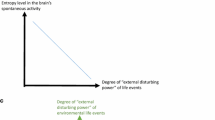Abstract
In this paper we address the interrelated questions of why and how certain features of an organism’s environment become meaningful to it. We make the case that knowing the biology is essential to understanding the foundation of meaning-making in organisms. We employ Miguel Nicolelis et al’s seminal research on the mammalian somatosensory system to enrich our own concept of brain-objects as the neurobiological intermediary between the environment and the consequent organismic behavior. In the final section, we explain how brain-objects advance the ongoing discussion of what constitutes a biosemiotic system. In general, this paper acknowledges Marcello Barbieri’s call for biology to make room for meaning, and makes a contribution to that end.





Similar content being viewed by others
Notes
See Harnad 1990.
See Searle 1980.
Those seeking a more technical account of the experiments should refer to Nicolelis’ 2008 publication.
We acknowledge Barbieri’s prescription for understanding meaning from the ground up, i.e., from molecules to animals, and in fact see the current paper as following from and building on the foundation we developed in our 2010 publication in this same journal on symbolic communication in the molecular realm (see Stillwaggon and Goldberg 2010).
Though, strictly speaking, our account suggests that the semiotic system on offer would be brain-environment, we recognize the limitations of the eliminative materialist approach in philosophy, according to which the mind is just the brain, and instead acknowledge the obvious: that brains are not independent entities, but necessarily dependent on host bodies embedded in host environments.
References
Barbieri, M. (2008a). Has biosemiotics come of age? And postscript. In M. Barbieri (Ed.), Introduction to biosemiotics (pp. 101–113). The Netherlands: Springer.
Baribieri, M. (2008b). Is the cell a semiotic system? In M. Barbieri (Ed.), Introduction to biosemiotics (pp. 179–207). The Netherlands: Springer.
Edelman, G. (1987). Neural Darwinism: The theory of neuronal group selection. New York: Basic Books.
Harnad, S. (1990). The symbol grounding problem. In Physica D, 42, 335–346.
James, W. (1911). Some problems of philosophy: A beginning of an introduction to philosophy. New York: Longmans, Green, and Co.
Nicolelis, M. (Ed.). (2008). Methods for neural ensemble recordings (2nd ed.). Boca Raton: CRC.
Nicolelis, M., & Ribeiro, S. (2006). Seeking the neural code. In Scientific American, 295(6), 70–77.
Pred, R. (2005). Onflow: Dynamics of consciousness and experience. Cambridge: MIT.
Searle, J. (1980). Minds, brains, and programs. Behavioral and Brain Sciences, 3(3), 417–457.
Stillwaggon Swan, L., & Goldberg, L. J. (2010). Biosymbols: symbols in life and mind. Biosemiotics, 3(1), 17–31.
Author information
Authors and Affiliations
Corresponding author
Rights and permissions
About this article
Cite this article
Swan, L.S., Goldberg, L.J. How Is Meaning Grounded in the Organism?. Biosemiotics 3, 131–146 (2010). https://doi.org/10.1007/s12304-010-9072-2
Received:
Accepted:
Published:
Issue Date:
DOI: https://doi.org/10.1007/s12304-010-9072-2




